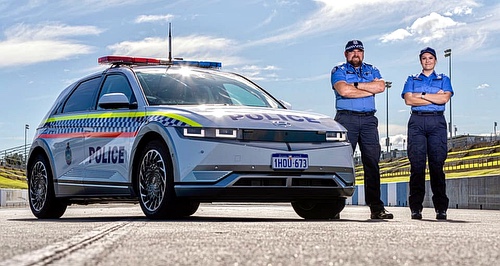News - General NewsWA Police trial NEVs for operational dutiesNew energy vehicles are being trialled in one of the world’s largest police jurisdictions6 Jun 2022 THE West Australian Police Force has announced it is the first Australian law-enforcement agency to trial new energy vehicles for frontline policing applications.
WA Police has taken delivery of a Hyundai Ioniq 5 battery-electric vehicle (BEV) and a Toyota Mirai hydrogen fuel cell electric vehicle (FCEV) to undergo testing in operational environments complete with markings and equipment including two-way radio, lights and sirens.
Acting Assistant Commissioner Allan Adams said the trial was part of the Western Australian Climate Policy, which outlines key government actions for a climate-resilient community and the transition to net-zero emissions.
“The WA Police Force has initiated research and testing of ‘green’ vehicles that may be suitable for operational policing,” said Assistant Commissioner Adams.
“Toyota and Hyundai have kindly provided vehicles to the WA Police Force for the purpose of a long-term full operational trial.”
However, like other vehicles selected for police duty, each car will have to satisfy a testing process if they are to be selected for operational work.
The Ioniq 5 will be trialled at State Traffic, Midland, Rockingham, Geraldton and Bunbury Police Stations, with the Mirai hitting the beat around the Fremantle District. The suitability of each vehicle will be evaluated after the trials.
Assistant Commisioner Adams added he was very keen to see how both cars progress.
“We’re putting a lot of effort into getting more of those cars out on the road, more frequently. So, certainly the cumulative effort of the introduction of electric cars into the fleet has a big value for the community,” he said.
“(But) the intent of the cars being introduced during this trial is to work out how well they put up with the rigours of operational policing.”
The fact the Ioniq 5's trial will include State Traffic and regional duties suggests that it will be considered a potential Class 1 police vehicle, making it suitable for highway patrol duties.
According to a video about vehicle testing on the WA Police website, this means satisfying a range of requirements.
“When you’re getting up to 120, 140 kilometres an hour, a vehicle has to respond in a certain way to be able to be classed as a Class 1 vehicle,” said Senior Sergeant Jeff Christmass of the force’s Driver Training Unit.
“If we are to put those vehicles on the road, we need to make sure they are first safe to drive in normal conditions but also at priority (emergencies).
“With priority comes a different set of circumstances and scenarios that police officers face every day through heavy traffic, going through different roads, freeways, and backstreets.
"All that sort of thing is taken into consideration so we put these vehicles through vigorous testing to make sure that the officer is safe and we can carry out our duty in a safe manner.”
“When we consider vehicles for a policing perspective, we look at not only the performance – which is the braking, acceleration, and handling – but also the ergonomics for our officers, and (our newest Kia, Skoda and Volkswagen) vehicles really come up to spec on that front,” Western Australia state traffic commander Mike Bell told GoAuto in March.
“(But) pure electric motor vehicles are the way of the future. We know we’ve got to head that way, so we’re starting to step into that space, and we’ll soon start looking widely into that field to see what the best vehicle for policing duties is.”
Western Australia’s 2.5 million square kilometre landmass is one of the largest police jurisdictions in the world and requires a diverse range of vehicle types ranging from Skoda Superb wagons to the Toyota LandCruiser 78 Series.
It will be some time before we see EVs replacing the latter, particularly in remote regions.
However, a few years ago when we started speculating which vehicles would replace the Holden Commodores and Ford Falcons that formed the backbone of Australian police fleets we never guessed that battery power could replace V8 muscle within five years.  Read more |
Click to shareGeneral News articlesResearch General News Motor industry news |

















Facebook Twitter Instagram